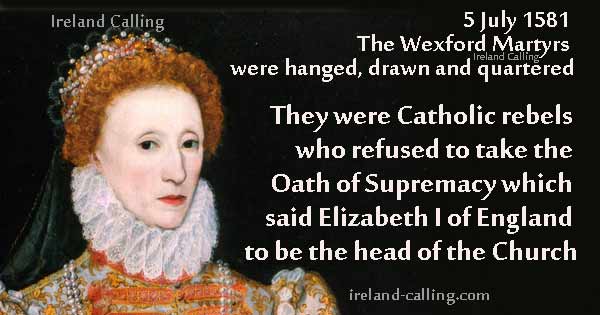The Wexford Martyrs were a small group of Catholic rebels who refused to take the Oath of Supremacy, which declared Elizabeth I of England to be the head of the Church.
They were found guilty of treason for aiding the escape of James Eustace, Viscount Baltinglass, who had supported the Desmond Rebellion against the British.
They were hanged, drawn and quartered in 1581, and were beatified by Pope John Paul II more than 400 years later.
The men who’ve gone down in history as the Wexford Martyrs were Matthew Lambert, Robert Myler, Edward Cheevers, Patrick Cavanagh and two others whose identity has never been discovered.

Their executions came against the backgound of the English Reformation, when Henry VIII rejected the authority of the Pope and Catholic Church and set up the Protestant Church of England.
His daughter, Queen Elizabeth continued his work both in maintaining the supremacy of the Protestant Church and in increasing English control over Ireland, which remained fiercely Catholic.
Elizabeth began a programme of planting English and Scottish Protestant settlers in key areas in Ireland, knowing they would be loyal to the Crown and help secure her authority over the country.
In addition, Catholics were obliged to take the Oath of Supremacy or risk losing their land and even their lives.
The British government were also placing an increasing number of Protestants into positions of authority in Ireland. The Irish people were forced to pay taxes to the Church of England, and were intimidated and harassed by British soldiers.
James Eustace, the Viscount Baltinglass, remained staunchly Catholic and resented the growing demands of Elizabeth and her suppression of Catholicism. His father had been already been imprisoned for his refusal to pay taxes to the Protestant Church.
Eustace rallied the local people of Wexford to rise up against these impositions. He was an intelligent man and knew that he couldn’t raise an army with the military skills and resources to tackle the British army.
Instead, he led his uprising to coincide with that of the Catholic revolt led by the Earl of Desmond in Munster. This allowed Eustace to catch the British unaware, with their attention already focussed on Munster.
This led to a short term success, but the British soon sent in reinforcements to crush Eustace’s rebellion.
Eustace fled to Spain. He eventually returned to Ireland but had to stay underground as there was a warrant out for his arrest. He found shelter with a Wexford baker named Matthew Lambert.
Someone notified the authorities of Eustace’s whereabouts. Lambert’s home was raided and he was arrested along with Eustace and his chaplain, Father Robert Rockford, and five sailors, Robert Myler, Edward Cheevers, Patrick Cavanagh and two others.
The men were tried for treason and offered a pardon if they would swear their allegiance to Queen Elizabeth. They refused.
Lambert responded to his inquisitors with this statement: “I am not a learned man. I am unable to debate with you, but I can tell you this, I am a Catholic and I believe whatever our Holy Mother the Catholic Church believes.”
All the men were tortured before being executed in Wexford on 5 July 1581. They went down in history as the Wexford Martyrs.
More popular articles and videos
The real life mystery of what Maureen O’Hara whispered to make John Wayne look so shocked
Matt Damon winning hearts and minds with charm assault on Ireland
Action hero Tom Cruise was once attacked by an old man in a Kerry pub
Liam Neeson speaks about his late wife in emotional interview
Dating site explains why Irish men make wonderful husband material
Billy Connolly says public should ignore politicians and listen to comedians
Take a look inside Hollywood star Saoirse Ronan’s stunning Irish home
